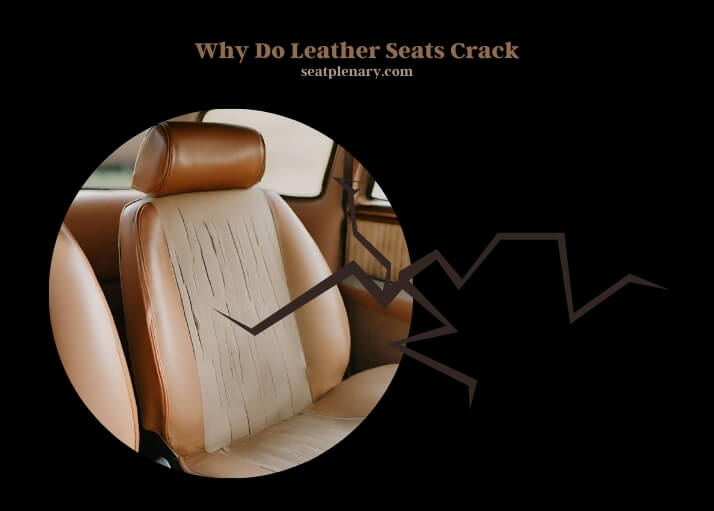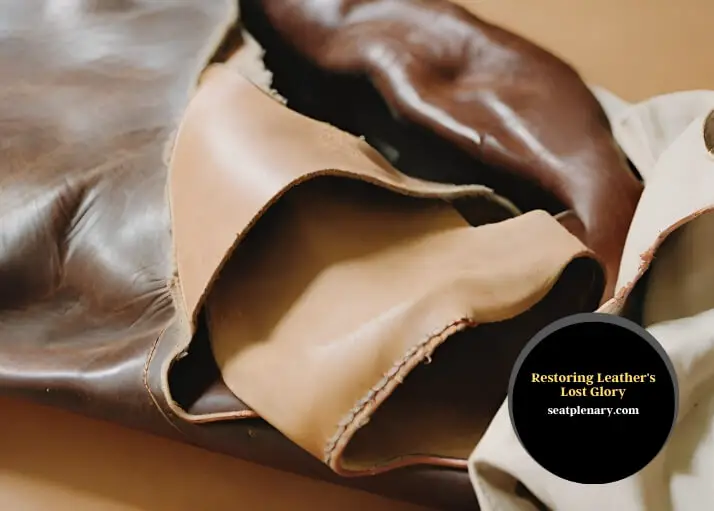Leather seats crack due to a lack of moisture and the natural aging process. Exposure to sunlight and heat accelerates this deterioration by breaking down the leather’s natural oils.
Leather, a durable yet delicate material, requires regular maintenance to retain its suppleness and prevent cracking. Over time, factors such as UV radiation from the sun, the dry air inside heated or air-conditioned spaces, and the wear and tear from use contribute to the loss of moisture in leather. This loss of moisture leads to the leather becoming dry and brittle, making it more susceptible to cracking. Regular conditioning is essential to replenish these natural oils, keeping the leather soft and flexible.
Cleaning products specifically designed for leather can help remove dirt and oils that degrade the material over time without causing additional harm. Protecting leather seats from excessive sunlight and heat by parking in shaded areas or using protective covers can also extend their lifespan.
These factors and implementing a routine care schedule can significantly reduce the risk of cracking, ensuring that leather seats maintain their comfort and aesthetic appeal for years to come.

Leather’s Vulnerability
Leather seats, synonymous with luxury and comfort, often face the inevitable fate of cracking. This deterioration stems from a blend of factors, notably prolonged exposure to sunlight. Sunlight’s ultraviolet rays break down the leather’s natural oils, diminishing its flexibility and leading to cracks.
Moisture, or rather the lack of it, plays a crucial role as well. Without regular conditioning, leather loses its softness, becoming brittle over time. The natural aging process also affects leather’s elasticity, making it more prone to damage. These elements combined spell the early demise of leather’s pristine condition if left unchecked.
Shielding Leather from Harm
The longevity of leather seats is not left to chance; it requires deliberate care and preventive measures. Employing protective treatments shields leather from the harsh effects of UV radiation. Opting for shaded parking or using car covers can significantly reduce sunlight exposure. Furthermore, cleanliness is next to godliness in leather care. Regular cleaning with suitable products prevents the accumulation of grime and oils that can further degrade the material.
The Chemistry of Leather Conditioning
Conditioners are the elixir of life for leather seats, designed to penetrate deep into the fibers, replenishing lost oils and ensuring the material remains supple. The choice between natural and synthetic conditioners hinges on the leather’s condition and age. Natural conditioners, rich in beeswax and lanolin, are perfect for rejuvenating older, dry leather. In contrast, synthetic options are better suited for newer, less worn leather surfaces.
Leather Conditioner Comparison
| Conditioner Type | Base Ingredient | Effectiveness | Recommended Use | Average Price Range |
| Natural | Beeswax, lanolin | High | Older, dry leather | $15 – $30 per 8 oz |
| Synthetic | Polymers, silicones | Moderate | Newer, less worn leather | $10 – $25 per 8 oz |
| Hybrid | Combination of natural and synthetic ingredients | High | All types of leather | $20 – $35 per 8 oz |
Restoring Leather’s Lost Glory
Cracks in leather seats are not a death sentence; they can be mended. The market offers a plethora of DIY repair kits and professional services tailored to leather restoration. The effectiveness of these solutions varies, with repair kits providing a quick fix for minor damage and professional services being necessary for more extensive wear.

Climate’s Toll on Leather
The environment plays a significant role in the health of leather seats. Extreme temperatures and fluctuating humidity levels can hasten the cracking process, necessitating more frequent maintenance. Utilizing dehumidifiers or humidifiers can mitigate these effects, creating a more conducive environment for leather preservation.
Leather Lifespan by Climate
| Climate Type | Average Lifespan (Years) | Maintenance Frequency | Additional Care Tips |
| Dry, Arid | 5-7 | High | Frequent conditioning, avoid direct sunlight |
| Humid, Tropical | 3-5 | Very High | Use dehumidifiers, regular mold prevention treatments |
| Temperate | 7-10 | Moderate | Standard conditioning and cleaning routines |
| Cold, Dry Winter | 6-8 | High | Use humidifiers, extra conditioning in winter months |
FAQs
Impact of Cleaning Products on Leather
Many off-the-shelf cleaning products contain chemicals that can degrade leather over time. Using harsh detergents or cleaners not specifically designed for leather can strip away natural oils, leading to dryness and cracking. It’s essential to choose pH-balanced leather cleaners that gently clean without causing damage. Regular use of inappropriate cleaning solutions accelerates the wear and tear on leather seats, emphasizing the importance of selecting the right products for leather care.
Role of Body Oils and Sweat
Human body oils and sweat are culprits in the deterioration of leather seats. Over time, these natural secretions penetrate the leather, breaking down its fibers and leading to cracks. The acids and salts present in sweat are particularly harmful, exacerbating the wear process. Preventative measures include using seat covers during workouts or hot days and regularly cleaning the leather to remove body oils and sweat residues.
Effects of Weight and Friction
The constant pressure and friction from sitting and moving on leather seats contribute to their cracking. Weight distribution and movement can stretch leather beyond its natural flexibility, causing stress cracks. Areas of the seat that endure the most use, such as the driver’s seat, are particularly vulnerable. Minimizing unnecessary friction and using cushions or seat supports can help distribute weight more evenly and reduce stress on the leather.
Influence of Animal Claws
Pets, particularly dogs and cats, can cause significant damage to leather seats with their claws. Even minor scratches can deepen over time, leading to cracks. Protecting leather seats with durable covers when pets are inside the vehicle or choosing pet-friendly seat materials can mitigate this risk.
Quality and Type of Leather
The inherent quality and type of leather used in seats play a significant role in their susceptibility to cracking. High-quality, full-grain leathers tend to be more durable and resistant to cracking compared to cheaper, bonded leathers.
The type of leather and its characteristics can guide proper care and maintenance routines, ensuring longevity and preventing premature cracking.
Environmental Pollutants and Contaminants
Exposure to environmental pollutants and contaminants like road salt, air pollution, and industrial chemicals can accelerate the degradation of leather seats. These substances can settle on the leather surface, slowly penetrating and breaking down the material. Regular cleaning to remove these contaminants is crucial in preserving the integrity of the leather.
Summary
Caring for leather seats involves understanding their vulnerabilities and taking proactive measures to mitigate them. From shielding leather from sunlight to employing the right conditioners and understanding the impact of climate, each step is crucial in extending the life and beauty of leather seats.
